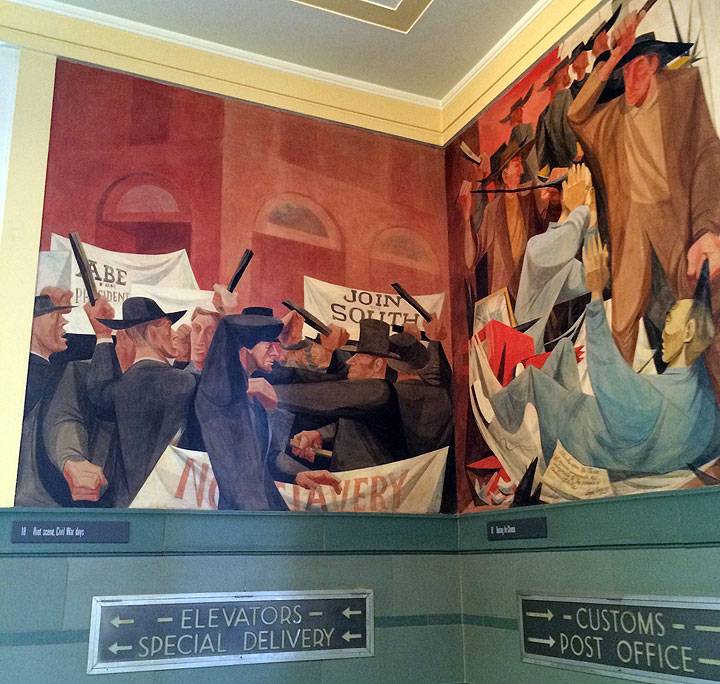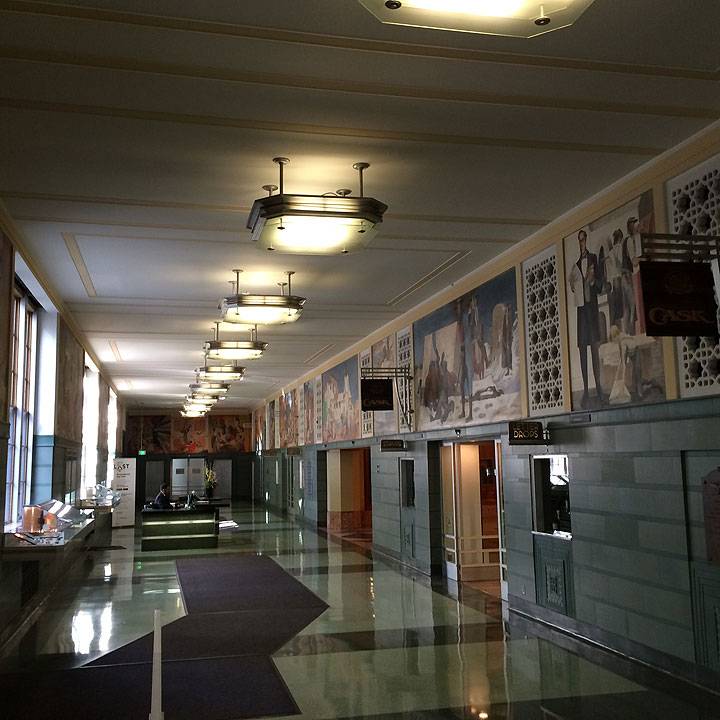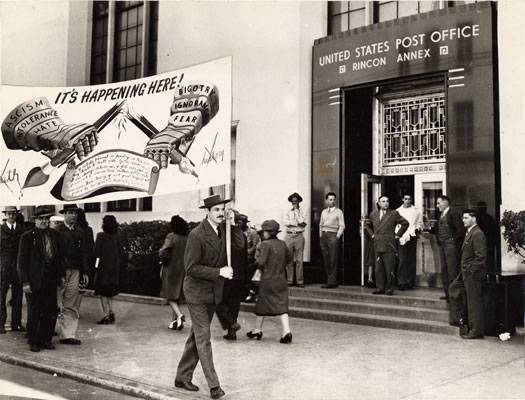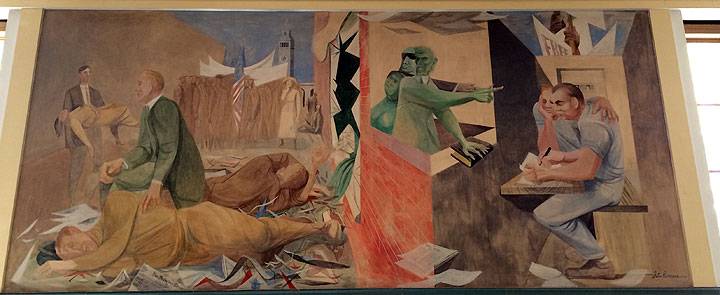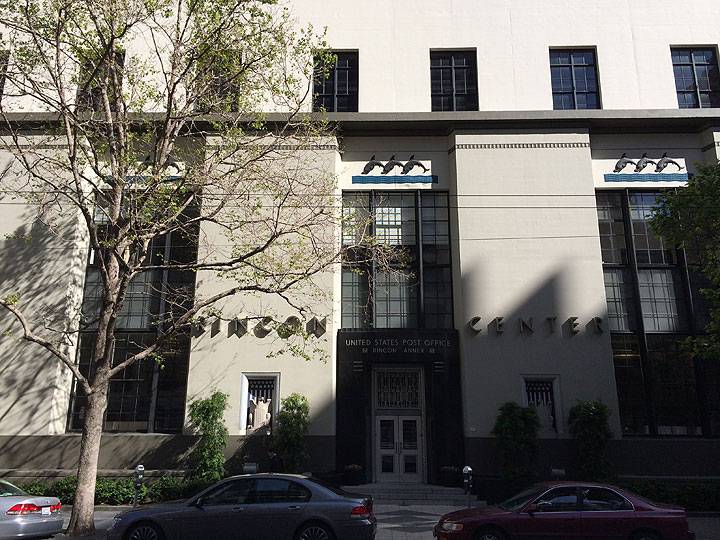Rincon Annex Post Office: Difference between revisions
(swapped in John Horn photos) |
No edit summary |
||
| (2 intermediate revisions by the same user not shown) | |||
| Line 15: | Line 15: | ||
''Photo: John Horn'' | ''Photo: John Horn'' | ||
The era of federal art in California closed as it began--with a fight over radical imagery in murals. In 1943, New Yorker Anton Refregier received a commission to paint the "History of San Francisco" in the Rincon Annex Post Office in San Francisco. The year was the last year of federal art sponsorship, and the murals themselves were not painted until after World War II. No longer feeling compelled to illustrate how hard work could end the economic depression, Refregier instead showed the past with all its blemishes, including vigilantes, anti-Chinese riots, and the waterfront strike of 1934.32 | The era of federal art in California closed as it began--with a fight over radical imagery in murals. In 1943, New Yorker Anton Refregier received a commission to paint the "History of San Francisco" in the Rincon Annex Post Office in San Francisco. The year was the last year of federal art sponsorship, and the murals themselves were not painted until after World War II. No longer feeling compelled to illustrate how hard work could end the economic depression, Refregier instead showed the past with all its blemishes, including vigilantes, anti-Chinese riots, and the waterfront strike of 1934.(32) | ||
In 1953 during the McCarthy period, Congress held hearings to determine if these offending murals in the San Francisco post office should be removed. Testifying for removal, a spokesman for the American Legion complained that "the murals do not reflect the romantic and inspiring history of California, and on the other hand tend to ridicule and slander the State and its pioneers.... These murals are not a matter of beauty or inspiration. They are depressing."33 | In 1953 during the McCarthy period, Congress [[Trial of the Rincon Annex Murals|held hearings]] to determine if these offending murals in the San Francisco post office should be removed. Testifying for removal, a spokesman for the American Legion complained that "the murals do not reflect the romantic and inspiring history of California, and on the other hand tend to ridicule and slander the State and its pioneers.... These murals are not a matter of beauty or inspiration. They are depressing."(33) | ||
Ironically, this statement by an anti-communist conservative could easily have been uttered by most California New Deal artists who painted fifteen years earlier. With only the very few exceptions noted above, California artists did not paint "depressing" murals during the Great Depression. They painted romantic and inspiring historical scenes because they looked to America's history as a source of strength in the battle with pressing contemporary problems.34 Accordingly, they refrained from painting images of contemporary problems because they believed that art should be inspiring for people. Having faith that the New Deal would revive the system that had operated so well in the past, they preferred to paint the world as it should be or as it should have been, not as it was. | [[Image:Artist Anton Refregier and C.I.O. longshoremen union members carrying a banner in protest for the covering up of a section of a mural at the Rincon Annex Post Office May 14 1948 AAK-0709.jpg]] | ||
'''Artist Anton Refregier and C.I.O. longshoremen union members carrying a banner in protest for the covering up of a section of a mural at the Rincon Annex Post Office, May 14 1948.''' | |||
''Photo: San Francisco History Center, San Francisco Public Library'' | |||
Ironically, this statement by an anti-communist conservative could easily have been uttered by most California New Deal artists who painted fifteen years earlier. With only the very few exceptions noted above, California artists did not paint "depressing" murals during the Great Depression. They painted romantic and inspiring historical scenes because they looked to America's history as a source of strength in the battle with pressing contemporary problems.(34) Accordingly, they refrained from painting images of contemporary problems because they believed that art should be inspiring for people. Having faith that the New Deal would revive the system that had operated so well in the past, they preferred to paint the world as it should be or as it should have been, not as it was. | |||
''--excerpted from ''"Working to Prosperity: California's New Deal Murals" by Steven M. Gelber in'' California History magazine,'' Summer 1979, Vol. LVIII, No. 2 | ''--excerpted from ''"Working to Prosperity: California's New Deal Murals" by Steven M. Gelber in'' California History magazine,'' Summer 1979, Vol. LVIII, No. 2 | ||
| Line 26: | Line 32: | ||
'''This panel depicts the Preparedness Bombing in 1916 and the railroading for [[TOM MOONEY|Tom Mooney]] and Warren Billings to jail in its aftermath.''' | '''This panel depicts the Preparedness Bombing in 1916 and the railroading for [[TOM MOONEY|Tom Mooney]] and Warren Billings to jail in its aftermath.''' | ||
[[Image:Rincon Exterior Horn 0034.jpg]] | |||
'''Rincon Annex exterior, 2014.''' | |||
''Photo: John Horn'' | |||
''article excerpted with permission of California Historical Society, San Francisco, CA'' | ''article excerpted with permission of California Historical Society, San Francisco, CA'' | ||
| Line 32: | Line 44: | ||
[[Bay Bridge Work | Prev. Document]] [[Coit Tower | Next Document]] | [[Bay Bridge Work | Prev. Document]] [[Coit Tower | Next Document]] | ||
[[category:SOMA]] [[category:Public Art]] [[category:1940s]] [[category:1950s]] [[category:1970s]] | [[category:SOMA]] [[category:Public Art]] [[category:1940s]] [[category:1950s]] [[category:1970s]] [[category:2010s]] [[category:downtown]] | ||
Latest revision as of 20:04, 17 March 2017
Historical Essay
by Steven M. Gelber
Rincon Annex Post Office Mural -- The Civil War
Mural by Anton Refregier, photo by John Horn
Rincon Annex lobby, restored and open 24 hours but no longer a post office. The murals encircle the upper walls of the lobby.
Photo: John Horn
The era of federal art in California closed as it began--with a fight over radical imagery in murals. In 1943, New Yorker Anton Refregier received a commission to paint the "History of San Francisco" in the Rincon Annex Post Office in San Francisco. The year was the last year of federal art sponsorship, and the murals themselves were not painted until after World War II. No longer feeling compelled to illustrate how hard work could end the economic depression, Refregier instead showed the past with all its blemishes, including vigilantes, anti-Chinese riots, and the waterfront strike of 1934.(32)
In 1953 during the McCarthy period, Congress held hearings to determine if these offending murals in the San Francisco post office should be removed. Testifying for removal, a spokesman for the American Legion complained that "the murals do not reflect the romantic and inspiring history of California, and on the other hand tend to ridicule and slander the State and its pioneers.... These murals are not a matter of beauty or inspiration. They are depressing."(33)
Artist Anton Refregier and C.I.O. longshoremen union members carrying a banner in protest for the covering up of a section of a mural at the Rincon Annex Post Office, May 14 1948.
Photo: San Francisco History Center, San Francisco Public Library
Ironically, this statement by an anti-communist conservative could easily have been uttered by most California New Deal artists who painted fifteen years earlier. With only the very few exceptions noted above, California artists did not paint "depressing" murals during the Great Depression. They painted romantic and inspiring historical scenes because they looked to America's history as a source of strength in the battle with pressing contemporary problems.(34) Accordingly, they refrained from painting images of contemporary problems because they believed that art should be inspiring for people. Having faith that the New Deal would revive the system that had operated so well in the past, they preferred to paint the world as it should be or as it should have been, not as it was.
--excerpted from "Working to Prosperity: California's New Deal Murals" by Steven M. Gelber in California History magazine, Summer 1979, Vol. LVIII, No. 2
This panel depicts the Preparedness Bombing in 1916 and the railroading for Tom Mooney and Warren Billings to jail in its aftermath.
Rincon Annex exterior, 2014.
Photo: John Horn
article excerpted with permission of California Historical Society, San Francisco, CA

